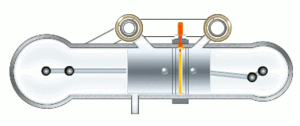The six-stroke engine is a type of internal combustion engine based on the four-stroke engine, but with additional complexity intended to make it more efficient and reduce emissions. Two different types of six-stroke engine have been developed since the 1990s:
In the first approach, the engine captures the heat lost from the four-stroke Otto cycle or Diesel cycle and uses it to power an additional power and exhaust stroke of the piston in the same cylinder. Designs use either steam or air as the working fluid for the additional power stroke.[1] The pistons in this type of six-stroke engine go up and down three times for each injection of fuel. There are two power strokes: one with fuel, the other with steam or air. The currently notable designs in this class are the Crower six-stroke engine, invented by Bruce Crower of the U.S. ; the Bajulaz engine by the Bajulaz S.A. company of Switzerland; and the Velozeta Six-stroke engine built by the College of Engineering, at Trivandrum in India.
The second approach to the six-stroke engine uses a second opposed piston in each cylinder that moves at half the cyclical rate of the main piston, thus giving six piston movements per cycle. Functionally, the second piston replaces the valve mechanism of a conventional engine but also increases the compression ratio. The currently notable designs in this class include two designs developed independently: the Beare Head engine, invented by Australian Malcolm Beare, and the German Charge pump, invented by Helmut Kottmann.
Diff Types of Six-stroke Engines:
- 1. Griffin six-stroke engine
- 2. Bajulaz six-stroke engine
- 3. Velozeta six-stroke engine
- 4. Crower six-stroke engine
- 5. Beare Head
- 6. M4+2
- 7. Piston charger engine
 |
| The M4+2 engine working cycle animation |

No comments:
Post a Comment